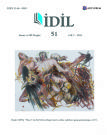DÜNYADA VE TÜRKİYE'DE ARAZİ SANATI (LAND ART)
LAND ART AROUND THE WORLD AND IN TURKEY
Author(s): Okşan Tandoğan, Burçin Erdi EsSubject(s): Architecture, Visual Arts, Sociology of Art, History of Art
Published by: Sanat ve Dil Araştırmaları Enstitüsü
Keywords: Arazi Sanatı; nature; art; landscape;
Summary/Abstract: Land Art is an art movement which emerged in the United States in the late 1960s and in the early 1970s in Europe, in which architecture, landscape and the work of art are inextricably bound up with each other. Aiming to inspire connection with nature and embrace nature rather than technology, Land Art expanded boundaries of art and developed outside of studios and gallery spaces, opposing capitalism’s logic. With a deeper understanding of environmental issues, the movement aims to reshape wide, open spaces in nature along with a specific concept, thereby aiming to connect humanity to nature and creating environmental awareness. For this purpose, land art creates artistic imagery using soil, rocks and other natural materials. The sense of land art was also a protest against the commercialization and exploitation of art since works of land art are not sellable or purchasable objects. The most prominent land artists are Alice Aycock, Christo, Michael Heizer, Nancy Holt, Walter De Maria, Mary Miss, Dennis Oppenheim, Robert Smithson, Michael Singer, Mel Chin, James Turrell, Ana Mendieta, Alan Sonfist Christian Phillip Müller, Jan Dibbet and British artists Richard Long, Hamish Fulton, and Andy Goldsworthy. Besides, the notable Turkish land artists are Mehmet Ali Uysal, Yücel Dönmez, Ayşe Erkmen, Mehmet Kavukcu, Cengiz Tekin, Mustafa Duyuluer, Varol Topaç and Elçin Ekici. This paper attempts to exam-ine the land art movement, the leading artists/works from all around the world alongside Turkish land artists and their works. According to the results of the research, it has been observed that there are not many examples of land art in Turkey where the land art movement developed especially after the late 2000s. Further, we cannot imply that these examples in Turkey refer to a sustainable creative movement.
Journal: İdil Sanat ve Dil Dergisi
- Issue Year: 7/2018
- Issue No: 51
- Page Range: 1359-1368
- Page Count: 10
- Language: Turkish

